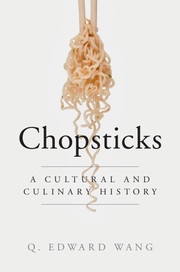Book contents
- Frontmatter
- Dedication
- Contents
- Acknowledgments
- List of Plates
- Timeline
- Map of East Asia
- 1 Introduction
- 2 Why chopsticks? Their origin and original function
- 3 Dish, rice or noodle? The changing use of chopsticks
- 4 Forming a chopsticks cultural sphere: Vietnam, Japan, Korea and beyond
- 5 Using chopsticks: customs, manners and etiquette
- 6 A pair inseparable: chopsticks as gift, metaphor and symbol
- 7 “Bridging” food cultures in the world
- Conclusion
- Glossary
- Bibliography
- Index
- Plate section
- References
7 - “Bridging” food cultures in the world
Published online by Cambridge University Press: 05 February 2015
- Frontmatter
- Dedication
- Contents
- Acknowledgments
- List of Plates
- Timeline
- Map of East Asia
- 1 Introduction
- 2 Why chopsticks? Their origin and original function
- 3 Dish, rice or noodle? The changing use of chopsticks
- 4 Forming a chopsticks cultural sphere: Vietnam, Japan, Korea and beyond
- 5 Using chopsticks: customs, manners and etiquette
- 6 A pair inseparable: chopsticks as gift, metaphor and symbol
- 7 “Bridging” food cultures in the world
- Conclusion
- Glossary
- Bibliography
- Index
- Plate section
- References
Summary
Real Chinese food is delicate and rare; supposed to be tasted rather than eaten, for the number of courses is stupendous. If really to the manner born, you reach into one general dish with your chop-sticks; it is a clean and delicate way to dine. Unless you go in for too much bird’s nest soup and century-old eggs, the prices are reasonable. Bird’s nest soup is delicious, but anyone can have my share of the heirloom hen fruit.
Harry Carr, Los Angeles: City of Dreams (New York, 1935)If you do not take your courage in hand, click your chopsticks together a few times to satisfy sceptical Chinese dinners that you can operate them, and plunge head first, so to speak, into real Chinese food, you cannot say that you have understood and savoured the taste of China.
George McDonald, China (Thomas Cook guide book) (Peterborough, 2002)Chopsticks are pronounced the same as “bridge” in Japanese, as mentioned previously. Since the mid-nineteenth century, after Asia became incorporated into the modern world, the eating tool has indeed played such a part in bridging food cultures in that continent and those around the globe. As Chinese food moves from “China to Chinatown,” to borrow the title of J.A. G. Roberts’s recent book, chopsticks have also traveled along the pathway to regions outside the chopsticks cultural sphere of Asia. For a non-Asian customer, using chopsticks to convey food, perhaps, is the culmination and crystallization of the dining experience in a Chinese/Asian restaurant. To cater to and cultivate such interest, many Chinese restaurant owners also use “chopsticks” to name their restaurants outside China, for example “Golden Chopsticks” and “Bamboo Chopsticks” are popular. Of course, chopsticks are not only found in Chinese restaurants, they are also provided for customers at Japanese, Korean, Vietnamese and sometimes Thai restaurants. As such, chopsticks use adds to the global appeal of Asian foods. If chopsticks are a “bridge,” they bring together food cultures not only between Asians and non-Asians but also among Asians.
- Type
- Chapter
- Information
- ChopsticksA Cultural and Culinary History, pp. 144 - 165Publisher: Cambridge University PressPrint publication year: 2015

